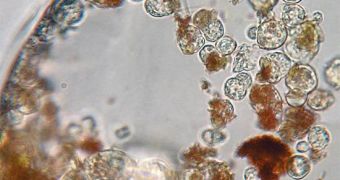A PhD student in the United States made arguably one of the most impressive discoveries in the field of paleobiology, when he discovered lifeforms that were more than 34,000 years old inside salt crystals collected from deep underneath the floor of Death Valley, in California.
The sample in question were collected years ago for climate studies, but were packed and stored away as soon as that particular investigation was finished. A PhD candidate discovered them again recently, and a second look revealed the ancient, buried lifeforms inside pinkish crystals.
“It was actually a very big surprise to me,” explains researcher Brian Schubert. While investigating the crystals, he and his team found tiny, fluid-filled chambers inside, which contained live bacteria.
The small chamber are only a few microns across in diameter, and experts in geology say that the formation of such crystals is not uncommon. The reason why the microorganisms were trapped inside is because these particular crystals grew very fast.
As such, they were able to trap whatever organisms were living in or around the water where they formed. “It's permanently sealed inside the salt, like little time capsules,” explains Tim Lowenstein.
The expert was Schubert's PhD advisor, and he holds an appointment as a professor at the Binghamton University Geology Department, Our Amazing Planet reports.
One of the most amazing things about the bacteria – except being alive after 34 millenia of imprisonment – is the fact that they have renounced all other physiological processes except survival
“They're alive, but they're not using any energy to swim around, they're not reproducing. They're not doing anything at all except maintaining themselves,” Schubert explains.
Details of the bacteria can be found in the January 2011 issue of GSA Today, the scientific journal published by the Geological Society of America. In the work, the expert shows that similar crystallization processes take place in modern saline lakes as well.
According to Schubert, who now holds an appointment as an assistant researcher at the University of Hawaii, the bacteria found inside the crystal exists naturally today as well. In order to survive, it entered a hibernation state of sorts.
There were a total of 900 micro-chambers that yielded samples, and of those, only 5 cultures grew. After two and a half months of intensive care, the bacteria sprung back to life, and began multiplying.
“It's 34,000 years old and it has a kid,” Schubert concludes.

 14 DAY TRIAL //
14 DAY TRIAL //